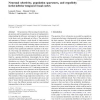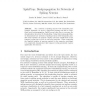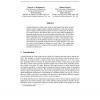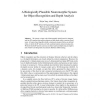92
Voted
BC
2007
15 years 28 days ago
2007
Abstract Thesparsenessoftheencodingofstimulibysingle neurons and by populations of neurons is fundamental to understanding the efficiency and capacity of representations in the br...
121
Voted
ESANN
2000
15 years 2 months ago
2000
Abstract. For a network of spiking neurons with reasonable postsynaptic potentials, we derive a supervised learning rule akin to traditional error-back-propagation, SpikeProp and s...
105
click to vote
NIPS
2003
15 years 2 months ago
2003
Decoding is a strategy that allows us to assess the amount of information neurons can provide about certain aspects of the visual scene. In this study, we develop a method based o...
90
Voted
NIPS
2003
15 years 2 months ago
2003
We present test results from spike-timing correlation learning experiments carried out with silicon neurons with STDP (Spike Timing Dependent Plasticity) synapses. The weight chan...
98
Voted
NIPS
2001
15 years 2 months ago
2001
We describe a programmable multi-chip VLSI neuronal system that can be used for exploring spike-based information processing models. The system consists of a silicon retina, a PIC...
108
Voted
NIPS
2004
15 years 2 months ago
2004
A typical neuron in visual cortex receives most inputs from other cortical neurons with a roughly similar stimulus preference. Does this arrangement of inputs allow efficient read...
104
Voted
NIPS
2004
15 years 2 months ago
2004
We propose a new interpretation of spiking neurons as Bayesian integrators accumulating evidence over time about events in the external world or the body, and communicating to oth...
72
Voted
ESANN
2003
15 years 2 months ago
2003
We propose an event-driven framework dedicated to the design and the simulation of networks of spiking neurons. It consists stract model of spiking neurons and an efficient event-d...
114
Voted
ESANN
2004
15 years 2 months ago
2004
Abstract. We present a large-scale Neuromorphic model based on integrateand-fire (IF) neurons that analyses objects and their depth within a moving visual scene. A feature-based al...
ESANN
2004
15 years 2 months ago
2004
Abstract. In this work we describe experimental results regarding an optoelectronic implementation of a dynamic neuron model. The model is a variation of the FitzHugh-Nagumo equati...




